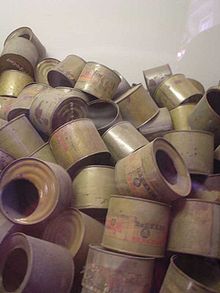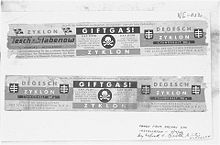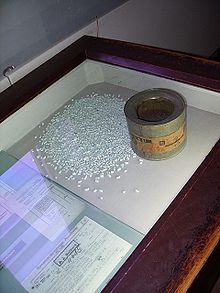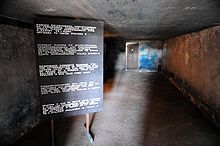- Zyklon B
-
This article is about the cyanide-based pesticide used against humans during the Holocaust. For the Norwegian black metal band, see Zyklon-B (band).
Zyklon B (German pronunciation: [tsykloːn ˈbeː]; also spelled Cyclon B or Cyclone B) was the trade name of a cyanide-based pesticide infamous for its use by Nazi Germany to kill human beings in gas chambers of extermination camps during the Holocaust. The "B" designation indicates one of two types of Zyklon. The other was "Zyklon A" – a liquid pesticide which released hydrogen cyanide in a chemical reaction with water.
It consisted of hydrogen cyanide (prussic acid, Blausäure in German, hence B[1]), a stabilizer, a warning odorant methyl 2-bromoacetate, and one of several adsorbents. Some Zyklon B did not contain the odorant: this has been explained variously, either that it was manufactured specifically for extermination purposes[2] or that this was because of supply shortages.[3]
Contents
History
Even before any of the modern methods of mass producing prussic acid were developed, suggestions were made that it could be used systematically to kill humans. A Berlin pharmacist is credited with the proposal to use rags with prussic acid placed on bayonets to combat the advancing Napoleonic army in 1813.[4] During World War I, the French army reportedly – according to Fritz Haber, the German chemist who helped develop poisonous gas for German Army use (see below) – used 2000 tons of prussic acid as a poison gas agent in artillery ammunition.[5]
Widespread 'biological' application of hydrocyanic acid was initially limited to the fumigation of valuable tree crops, namely of citrus fruit, spreading 1887 from California[6] to Spain and other countries using liquid prussic acid or calcium cyanide or sodium cyanide preparations. During World War I other HCN-based pest control applications were developed, and soon fumigation of ships, stores, factories, and even residential buildings with hydrocyanic acid gas became a popular method of combatting insect and rodent pests in many countries.[7] Thousands of ships, cereal mills and other food processing factories were fumigated with hydrocyanic acid gas until the mid 1930s in Germany alone.
Degussa ("Deutsche Gold- und Silber-Scheideanstalt") had a leading role in the German research on pest control with hydrocyanic acid gas from 1916/17 on.[8] Degussa's expertise in handling HCN resulted from its use in the extraction of gold from gold ore. Initially, the so-called pot method was used to simply generate HCN gas by treating sodium cyanide or potassium cyanide with diluted sulfuric acid in a pot.[9] The pot method has a number of disadvantages – as has the utilisation of highly concentrated liquid prussic acid. The disadvantages of both methods are prussic acid's limited chemical stability for long-term storage, and the formation of a highly explosive air-HCN mixtures upon application.
In March 1919 Deutsche Gesellschaft für Schädlingsbekämpfung mbH (Degesch) was founded by a consortium of German chemical companies including Degussa, and initially led by chemistry Nobel laureate Fritz Haber. Haber had World War I experience in the development of poison gas for the German chemical warfare program. At Degesch, Ferdinand Flury developed Zyklon A in 1920. Its development was a major advance over previous methods of delivering hydrocyanic acid for pest control because of its improved chemical stability and the presence of a warning odorant.[10]
Walter Heerdt, Bruno Tesch and Gerhard Peters were all collaborators of Fritz Haber working at the Kaiser Wilhelm Institute for Physical Chemistry and Electrochemistry at Berlin-Dahlem. Out of this group of Haber assistants, Walter Heerdt was named the official inventor of Zyklon B in a Degesch patent application from 20 June 1922 (number DE 438818). Reichspatentamt awarded the patent on 27 December 1926.[11] The main invention in Zyklon B consisted of the absorption of liquid hydrocyanic acid into a highly porous adsorbent. Initially, heated diatomite (diatomaceous earth) was used as an adsorbent. Later, high-porosity gypsum pellets called Erco-dice (described by eye witnesses as "crystals") as well as disks made from wood fibre were also used. The adsorbed hydrocyanic acid was very safe in handling and storage when placed in inexpensive airtight cans of various sizes.[12] Gerhard Peters, manager of Degesch, cites M. Kaiser to the effect that
"Heute ist die Zyklon-Blausäure als "das Mittel der Wahl" [...] nicht nur zur Entwanzung und Entlausung, sondern ganz allgemein zur Entwesung großer Räume in allen Erdteilen bekannt. (Today Zyklon-prussic acid is known as the means of choice [...] not only for debugging and delousing but also, in general, for the extermination of large spaces in all quarters of the globe.)
From 1929 onwards the U.S. used Zyklon B to disinfect the freight trains and clothes of Mexican immigrants entering the US.[13] Farm Securities Administration photographer Marion Post Wolcott recorded the use of cyanide gas and Zyklon B by the Public Health Service at the New Orleans Quarantine Station during the 1930s.[14]
In early 1942, Zyklon B had emerged as the preferred extermination tool of the Nazi regime for both the Auschwitz-Birkenau and Majdanek extermination camps during the Holocaust. The chemical claimed the lives of roughly 1.2 million people in these camps. Rudolf Höss, commandant of Auschwitz, said that the use of Zyklon-B came about on the initiative of one of his subordinates, Captain Frisch, who used the substance to murder some Russian POWs in late August 1941. The experiment was repeated on more Russian POWs, with Hoess watching, in September of the same year.[15] The emergence of Zyklon-B as the preferred chemical was a multi-stranded process.[16]
Production
Degesch (short for "Deutsche Gesellschaft für Schädlingsbekämpfung mbH"; lit. German Limited Company for Pest Control") played a key role in the development (see above) and manufacturing of Zyklon B. Many German companies had stock in Degesch, but all eventually sold their shares to the chemical giant Degussa (now part of Evonik Industries) in the early 1920s. To raise capital, Degussa split its controlling interest of Degesch with IG Farben in 1930: both companies held a 42.5% share in Degesch, with the remaining 15% held by the Th. Goldschmidt AG of Essen.[citation needed]
Degesch's role at this point was limited to acquiring patents and intellectual property: it did not itself produce Zyklon B. The manufacture of Zyklon B was handled by Dessauer Werke für Zucker and Chemische Werke, which acquired the stabilizer from IG Farben, the warning agent from Schering AG and the prussic acid from Dessauer Schlempe company and assembled them into the final product. Dessauer Schlempe extracted prussic acid from the waste products of the sugar beet refining process. Apart from Dessauer Werke, Zyklon B was also produced from 1935 in Kaliwerke AG in the Czech town of Kolín[17][18] and in France.[19][20]
Upon production, Zyklon B was sold by Degesch to Degussa. To cut costs, Degussa sold the marketing rights of Zyklon B to two intermediaries: the Heerdt and Linger GmbH (Heli) and Tesch & Stabenow (Tesch und Stabenow, Internationale Gesellschaft für Schädlingsbekämpfung m.b.H., or Testa) of Hamburg. Both suppliers split their territory along the Elbe river, with Heli handling the clients to the west and Testa those to the east.[21]
Zyklon B is still in production in the Czech Republic in the factory Draslovka Kolín a.s. in the city of Kolín, under the tradename Uragan D2, and is sold for the purpose of eradicating insects and small animals. The Czech word uragan means "hurricane" or "cyclone" in English.[22][23]
Use on humans
Use by Nazi Germany
Zyklon B was used by Nazi Germany to poison prisoners in the gas chambers of their network of extermination camps throughout Europe. Zyklon B was used at Auschwitz Birkenau, Majdanek and at Sachsenhausen. Most of the victims were Jews and the Zyklon B gas became a central symbol of the Holocaust. (Zyklon B was also briefly tried out at Bełżec, one of the Operation Reinhard camps, but soon dropped in favour of carbon monoxide from engine exhaust as the gassing agent of choice.)[citation needed]
Zyklon B was used in the concentration camps also for delousing to control typhus. The chemical used in the gas chambers was deliberately made without the warning odorant.[24] In quantitative terms, more than 95% of the Zyklon B delivered to Auschwitz was used for delousing and less than 5% in the gas chambers.[25]
In January or February 1940, 250 Gypsy children from Brno in the Buchenwald concentration camp were used as guinea pigs for testing the Zyklon B gas.[26] On September 3, 1941, around 600 Soviet prisoners of war and 250 sick Polish prisoners were gassed with Zyklon B at Auschwitz camp I; this was the first experiment with the gas at Auschwitz. The experiments lasted more than 20 hours.
According to Rudolf Höss, commandant of Auschwitz, bunker 1 held 800 people, and bunker 2 held 1,200.[27] Once the chamber was full, the doors were screwed shut and solid pellets of Zyklon B were dropped into the chambers through vents in the side walls, releasing the cyanide gas. Those inside died within 20 minutes; the speed of death depended on how close the inmate was standing to a gas vent, according to Höss, who estimated that about one third of the victims died immediately.[28][29] Johann Kremer, an SS doctor who oversaw the gassings, testified that: "Shouting and screaming of the victims could be heard through the opening and it was clear that they fought for their lives."[30] When they were removed, if the chamber had been very congested, as they often were, the victims were found half-squatting, their skin colored pink with red and green spots, some foaming at the mouth or bleeding from the ears.[29]
Post-WW2 legacy
After the war, two directors of Testa – Bruno Tesch and Karl Weinbacher – were tried by a British military court and were executed for their part in supplying the chemical.
The use of the word Zyklon (German for cyclone) continues to prompt angry reactions from Jewish groups. In 2002, both Siemens and Umbro[citation needed] withdrew attempts to use or trademark the term for their products.[31]
Holocaust deniers say that Zyklon B gas was not used in the gas chambers, relying as evidence on the low levels of Prussian blue residue in samples of the gas chambers found by Fred A. Leuchter, which Leuchter dismissed as the results of general delousing of buildings. Leuchter's negative control, a sample of gasket material taken from a different building in the camp, registered as having no such cyanide residue.[32] The manager of the analytical laboratory hired by Leuchter states in an interview in Errol Morris' film Mr. Death: The Rise and Fall of Fred A. Leuchter, Jr., that Leuchter's thick samples of brick would have greatly diluted the cyanide residue, which forms only an extremely fine layer on the walls and cannot penetrate.
In 1994, the Institute for Forensic Research in Kraków re-examined this claim on the grounds that formation of Prussian blue by exposure of bricks to cyanide is not a highly probable reaction.[33] Using more sophisticated microdiffusion techniques, they tested 22 samples from the gas chambers, delousing chambers (as positive controls), and living quarters (as negative controls), finding cyanide residue in both the delousing chambers and the ruins of the gas chambers but none in the ruins of the living quarters.[34]
Mechanism
Zyklon B is a cyanide-based poisonous gas that interferes with cellular respiration. Specifically, it prevents the cell from producing ATP by binding to one of the proteins involved in the electron transport chain. This protein, cytochrome c oxidase, contains several subunits and has ligands containing iron groups. At one of these iron groups, heme a3, the cyanide component of Zyklon B can bind, forming a more stabilized compound through metal-to-ligand pi bonding. As a result of this new iron-cyanide complex, the electrons which would situate themselves on the heme a3 group can no longer do so. Instead, because of the new bond formed between the iron and the cyanide, these electrons would actually destabilize the compound (based on molecular orbital theory); thus, the heme group will no longer accept them. Consequently, electron transport is halted, and the cell can no longer produce the energy needed to synthesize ATP.
References
- ^ Dwork, Deborah; van Pelt, Robert Jan (1996). Auschwitz, 1270 to the present. Norton. p. 443. ISBN 0393039331.
- ^ LG Frankfurt am Main vom 27.5.1955, 4a Ks 1/55. "Gerstein habe dann gefragt, ob Zyklon ohne Reizstoff geliefert werden könne, und habe, als er die ablehnende Haltung des Angeklagten bemerkte, erklärt, dass es sich um 'legale Hinrichtungen', in einzelnen Fällen um Sterbehilfe handle. [...] Man habe sich dann auf die Lieferung von monatlich 200 kg geeinigt."
- ^ http://www.holocaust-history.org/auschwitz/pressac/technique-and-operation/pressac0017.shtml
- ^ Blausaeure zur Schaedlingsbekaempfung: Prussic Acid in Pest Control. Holocaust-history.org (1998-01-23). Retrieved on 2011-04-19.
- ^ Peters, Blausäure zur Schadlingsbekampfungen (Stuggart, 1933), p. 17 citing in footnote 84 Fritz Haber, "Zur Geschichte des Gaskriegs" in "5 Vortraege", Berlin, p. 81, note 3
- ^ The Efficiency of Prussic Acid Fumigation at Low Temperatures. Holocaust-history.org. Retrieved on 2011-04-19.
- ^ Peters [1] cites a 1932 USDA bulletin where it is recommended even for careful private use
- ^ Blausaeure zur Schaedlingsbekaempfung: Prussic Acid in Pest Control. Holocaust-history.org (1998-01-23). Retrieved on 2011-04-19.
- ^ Blausaeure zur Schaedlingsbekaempfung: Prussic Acid in Pest Control. Holocaust-history.org (1998-01-23). Retrieved on 2011-04-19.
- ^ Blausaeure zur Schaedlingsbekaempfung: Prussic Acid in Pest Control. Holocaust-history.org (1998-01-23). Retrieved on 2011-04-19.
- ^ US 0
- ^ Peters [2] and following pages
- ^ Spike, Paul (2007-05-31). "How America inspired the Third Reich.". The First Post. http://www.thefirstpost.co.uk/index.php?storyID=7083. Retrieved 2008-09-12.
- ^ Photographs are retained in the National Library of Medicine. WA 234AL6 no. 2
- ^ Höss, Death Dealer, pp. 155–56, cited in Christopher Browning, The Origins of the Final Solution (Nebrask Univ Press/Yad Vashem, 2004), pp. 526–27, n. 208, 209, 210.
- ^ Christopher Browning, Origins of the Final Solution, (Lincoln, NB/Jerusalem: Univ of Nebraska Press/Yad Vashem, 2004), pp. 356–58.
- ^ Kaliwerke Kolin
- ^ Miloš Hořejš, Ivana Lorencová (eds.): Věda a technika v českých zemích v období 2. světové války, p. 326
- ^ SOFUMI
- ^ Zyklon B: la France n'a pas fourni les camps. Le groupe français Ugine a bien fabriqué l'insecticide,mais il n'approvisionnait pas les SS
- ^ Christainson, Scott (2010). The Last Gasp: The Rise and Fall of the American Gas Chamber. University of California Press. p. 166. ISBN 9780520255623. http://books.google.com/books?id=AIzaoHoggUwC.
- ^ Product page
- ^ "Google Translation of the Adezin s.r.o. Product Information Page". http://translate.google.com/translate?u=http%3A%2F%2Fwww.adezin.cz%2F%3Fl%3Dcz%26i%3D8&sl=cs&tl=en&hl=en&ie=UTF-8. Retrieved 2008-09-12.
- ^ Van Husen, William H. Zyklon B. World War II in Europe: An Encyclopedia. 1999.
- ^ Auschwitz: Technique and Operation of the Gas Chambers
- ^ Emil Proester, Vraždění čs. cikánů v Buchenwaldu (The murder of Czech Gypsies in Buchenwald). Document No. UV CSPB K-135 on deposit in the Archives of the Museum of the Fighters Against Nazism, Prague. 1940. (Quoted in: Miriam Novitch, Le génocide des Tziganes sous le régime nazi (Genocide of Gypsies by the Nazi Regime), Paris, AMIF, 1968)
- ^ Piper, Franciszek. "Gas chambers and Crematoria," in Berenbaum, Michael & Gutman, Yisrael (eds). Anatomy of the Auschwitz Death Camp, Indiana University Press and the United States Holocaust Memorial Museum, 1994, p. 162.
- ^ Auschwitz: Zyklon B
- ^ a b Piper, Franciszek. "Gas chambers and Crematoria," in Berenbaum, Michael & Gutman, Yisrael (eds). Anatomy of the Auschwitz Death Camp, Indiana University Press and the United States Holocaust Memorial Museum, 1994, p. 170.
- ^ Piper, Franciszek. "Gas chambers and Crematoria," in Berenbaum, Michael & Gutman, Yisrael (eds). Anatomy of the Auschwitz Death Camp, Indiana University Press and the United States Holocaust Memorial Museum, 1994, p. 163.
- ^ "Siemens retreats over Nazi name". BBC News. 2002-09-05. http://news.bbc.co.uk/2/hi/business/2233890.stm. Retrieved 2010-04-20.
- ^ Shofar FTP Archive File: cyanide.002 The Nizkor Project
- ^ Amoklauf gegen die Wirklichkeit. Praca zbiorowa; B. Gallanda, J. Bailer, F. Freund, T. Geisler, W. Lasek, N. Neugebauer, G. Spenn, W. Wegner; Bundesministerium fuer Unterricht und Kultur Wien, 1991
- ^ "A Study of the Cyanide Compounds Content in the Walls of the Gas Chambers in the Former Auschwitz and Birkenau Concentration Camps". The Institute for Forensic Research, Cracow. 2000-01-15. http://www.holocaust-history.org/auschwitz/chemistry/iffr/report.shtml. Retrieved 2008-09-12.
External links
- Chemistry is Not the Science – a critique of the arguments of Holocaust deniers regarding the use of Zyklon B in gas chambers.
- URAGAN D2 (Czech)
Categories:- Cyanides
- German inventions
- Infrastructure of the Holocaust
- Pesticides
- Blood agents
Wikimedia Foundation. 2010.




